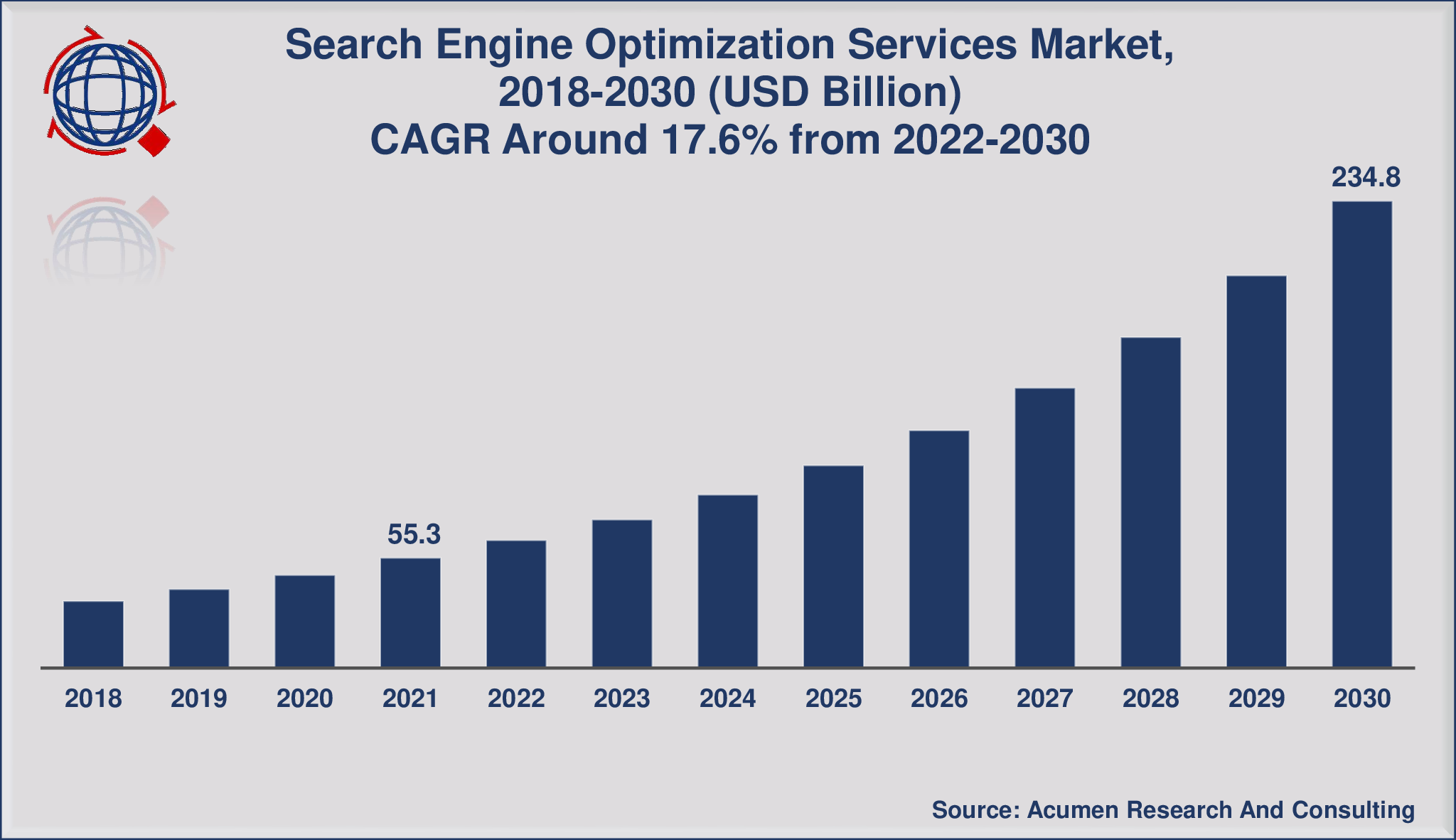SEO Statistics And Facts To Help You Rank Higher In 2024

Wondering about the state of search engine optimisation and ‘how to rank’ in 2024?
As we start 2024 with the learnings of 2023, the landscape of Search Engine Optimisation (SEO) continues to evolve at a rapid pace, driven by changing algorithms, user behaviors, and web advancements. From the importance of mobile optimisation and voice search to the ever-growing significance of content quality and user experience, the data emerging in 2023 offers invaluable insights.
These statistics not only shed light on current trends but also guide strategic decisions in the digital marketing realm. In this context, we delve into some of the most compelling SEO facts and statistics for 2024, providing a foundation for understanding how to navigate the complexities of SEO effectively in today’s digital ecosystem.
SEO demand has always been increasing and these statistics and facts make it very clear why you should start working on your website’s search engine rankings. With so much data accessible today, it’s critical for businesses to remain on par with the SEO industry statistics standards, the newest SEO trends and statistics to ensure that their tactics are current and successful.
In this blog, we’ll look at some of the recent and significant SEO numbers and statistics, providing you with a thorough overview of the SEO industry’s most recent trends and insights so that you can implement those on your SEO strategy. With this post, we aim to give you essential information to help you optimise your website and increase your search engine rankings. It does not matter if you are a seasoned SEO specialist or just starting out, these facts and statistics can be of great help to you.
Table of Contents
- General search engine statistics
- Backlinks Stats
- Technical SEO Statistics
- Local SEO Statistics
- Voice, Video, and Structured Data SEO Statistics
- Marketing
- Mobile SEO Statistics
- On-Page/Content SEO Statistics
- Keyword
- Conclusion
General search engine statistics
- Google dominates the global search engine market share with an 84.69%, followed by Bing (8.85%) and Yahoo (2.59%), as of January 2023. (Statistica)

- 68% of all online experiences begin with a search engine. (BrightEdge)
- 90.63% of all web pages get no organic search traffic from Google. (AHREFS)
- Google uses over 200 ranking factors to determine search results. AHREFS
- 70-80% of users ignore the paid ads and focus on the organic results (Gitnux)
- The #1 result in Google receiving approximately 32% of all clicks. (Backlinko)
- 53.3% of website traffic comes from organic search. (BrightEdge)
- SEO leads have a 14.6% close rate. (HubSpot)

- Only 5.7% of pages will rank in the top 10 search results within a year of publication. (Ahrefs)
- The average page in the top 10 search results is 2+ years old. (Ahrefs)
- There are an estimated 3.5 billion searches on Google each day. (Internet Live Stats)
- The #1 Google organic search result has an average click-through rate (CTR) of 31.7%, and this result is 10x more likely to get a click compared to the tenth result. (Backlinko)
- Only 22% of pages that rank in the top 10 are created within the same year. (Ahrefs)
- Newly published pages from high DR websites (DR >= 80) have a better chance of ranking on the first page quickly compared to low DR sites (DR < 30). (Ahrefs)
- Improving your search engine ranking by just one position can increase your CTR by an average of 2.8%. However, the impact of moving up one position depends on where you are starting from and where you are moving to. (Backlinko)
- Moving from position 10 to position 9 can increase the CTR by 143% while moving from position 2 to position 1 can increase the CTR by 33%. (Advanced Web Rankings)
- Approximately 21% of searchers click on multiple search results (Moz).
Backlinks Stats
- According to a study by Backlinko, the number of domains linking to a page has the strongest correlation with its ranking on Google.
- The average cost of buying a link is $361.44. (Ahrefs)
- 66.31% of pages have no backlinks. (Ahrefs)
- 73.6% of domains have reciprocal links, meaning that some of the sites they link to also link to them. (Ahrefs)
- 66.5% of links to sites in the last nine years are dead. (Ahrefs)
- On average, long-form content gets 77.2% more backlinks than shorter articles (Backlinko).
- Businesses that maintain a blog receive 97% more backlinks to their website (HubSpot).
Technical SEO Statistics
- HTTPS Correlates with Higher Rankings (About SSL)
- Websites with a blog have 434% more indexed pages (HubSpot)
- 95% of traffic across Google is encrypted. (Google).
- A website’s domain authority (DA) is a key factor in SEO. Websites with a DA of 50 or higher tend to rank better in search engine results pages (Moz).
- Nearly 70% of consumers admit that page speed impacts their willingness to buy from an online retailer. (Instant Commerce)
Local SEO Statistics
- Websites that use Google My Business can see up to a 70% increase in-store visits. (Google)
- 88% of consumers who search for a type of local business on a mobile device call or visit that business within 24 hours. (Source: Hubspot)
- 72% of consumers who perform a local search will visit a store within 5 miles of their current location (Source: HubSpot)
- 50% of consumers who conducted a local search on their smartphone visited a store within a day (Source: Think With Google)
- A study by Google found that 18% of local smartphone searches led to a purchase within a day compared to 7% of non-local searches. (Google Think Storage)
- 78% of location-based mobile search result in an offline purchase. (Hubspot)
- According to a study, 50% of consumers who searched for a local business on their smartphone visited a physical store within 24 hours. Additionally, 34% of those who performed the same search on a computer or tablet also visited a store within a day. (Google)
Looking to connect with your local audience? Our Melbourne local SEO services can help your website get potential customers looking for your services in your locality. Let’s have a chat about boosting your local leads!
Voice, Video, and Structured Data SEO Statistics
- Pages with video are 50 times more likely to appear on the first page of Google search results. (Forrester)
- 20% of searches in Google App are done by voice searches. (ThinkWithGoogle)
- Pages with structured data rank on average four positions higher in search engine results pages (SERPs). (Search Engine Watch)
- Websites that use structured data can see up to a 30% increase in click-through rates (CTRs) in search engine results pages (SERPs). (Search Engine Land)
- 14% of people use voice search assistance search while driving. (Oberlo)
- 58% of consumers have used voice search to find local businesses. 27% visit a local business website after making a voice search. (Score.org)
- Over a quarter (27%) of the global online population is using the voice search feature on their mobile devices. (GlobalWebIndex).
- 91% of consumers are more likely to use a business with positive online reviews. (BrightLocal)
- 12.29% of search queries have featured snippets in their search results. (Ahrefs)
Marketing

- 70% of marketers say SEO is more effective than PPC (Databox)
- 57% of B2B marketers stated that SEO generates more leads than any other marketing initiative (Digital Logic)
- 61% of marketers say improving SEO and growing their organic presence is their top inbound marketing priority (HubSpot)
- 64% of marketers actively invest time in search engine optimisation (HubSpot)
- 60% of marketers say inbound (SEO, blog content, etc.) is their highest quality source of leads ( Ahrefs)
- 72% of online marketers describe content creation as their most effective SEO tactic (WP Forms)
- As the number of elements – text, titles, images – on a page goes from 400 to 6,000, the probability of conversion drops 95%. (ThinkWithGoogle)
- Websites that load in 1 second have 3x higher conversion rates compared to those that load in 5 seconds. (Google Developers)
Mobile SEO Statistics
- Mobile devices account for over half of all website traffic (Statista)
- As page load time goes from one second to 10 seconds, the probability of a mobile site visitor bouncing increases by 123%. (ThinkWithGoogle)
- A one-second website speed improvement can increase conversions for mobile users by up to 27%. (Google)
- Mobile users are slightly more patient and would wait between 6-10 seconds before abandoning the site. (Openweb)
- Mobile searches for “can you use” terms have grown by 90% in the last two years. (ThinkWithGoogle)
- Over 50% of smartphone users have discovered a new company or product when conducting a search on their smartphone (Digitallogic)
- Mobile searches for “best” have increased by 80% over the past two years (Think With Google)
- Improving mobile page speed from 15 to 3 seconds can increase mobile conversion rates by up to 27%. (ThinkWithGoogle)
- 82% of smartphone users consult their phones while in a store deciding what to buy (ROBO Economy)
- 75% of mobile searches result in a store visit within 24 hours (Acquisio)
- 71% of in-store shoppers who use smartphones for research say their device has become more important to their in-store experience (Invesp)
- 60% of smartphone users have contacted a business directly using the search results, such as the “click to call” option (Think With Google)
- 53% of mobile site visits are abandoned if pages take at most 3 seconds to load. (Google)
- The average time it takes to fully load a mobile landing page has dropped by seven seconds. (Think with Google)
On-Page/Content SEO Statistics
- Websites that publish blog content have 434% more indexed pages than those that don’t (HubSpot)
- Updating and republishing old blog posts with new content and images can increase organic traffic by as much as 106% (HubSpot)
- The average word count of top-ranking content in Google is 1,447 words (Backlinko)
- Pages with a meta description have a 5.8% higher click-through rate than those without (Kinsta)
- Content with at least one image gets 94% more views than content without images (Jeff Bullas)
- 89% of marketers worldwide rated SEO as successful at achieving improved search rankings, increased site traffic, and lead generation.(Digital Marketing Institute)
- 75% of SEO is off-page and 25% is on-page (HubSpot)
- 7.4% of top-ranking pages don’t have a title tag. (Ahrefs)
- Google is now 33% more likely to rewrite title tags. (Ahrefs)
- Pages with URLs that contain a keyword have a 45% higher CTR. (SEJ)
- Title tags between 15-40 characters have an 8.6% higher CTR than lengthier ones. (Backlinko)
- Only 74.98% of top-ranking pages have a meta description – which is a missed opportunity given they factor into search rankings. (Ahrefs)
Keyword
- Long-tail keywords make up 70% of all Google searches (HubSpot)
- Pages with the keyword in the URL rank on average 45% higher in search engine results pages (SERPs). (Backlinko)
- Keywords between 10-15 words in length get 1.76x more clicks than single-word terms. (Backlinko)
- 15% of all Google searches have never been searched before. (Google)
- 50% of searches are four words or longer. (HubSpot)
- Keywords that are longer, between 10-15 words in length, tend to have a higher click-through rate (CTR), with 1.76 times more clicks than single-word terms. (Backlinko)
Related read: Why is fulfilling search keyword intent crucial in 2023?
Conclusion
Let’s have a look at what we discussed in this blog at a glance.
Recent studies show that a huge chunk of all online journeys begins with a search on engines like Google which clarifies the significance of SEO in today’s digital world. Furthermore, websites that appear on the first page of Google search results earn significantly more overall traffic, with the remaining pages receiving less than 10%. This means that if your website does not appear on the first page of organic search results, you are certainly missing out on a substantial number of prospective clients.
Another important SEO Statistics for 2023 consideration is the rise of mobile or smartphone searches, which now account for more than half of all internet users globally. As a result, search engines have increased their attention to mobile-friendly websites.
Unsurprisingly, mobile responsiveness is an important ranking factor making it more crucial than ever to establish a mobile-friendly website. Furthermore, SEO is not just limited to high rankings in search results. Use the data provided by Google Analytics and other tools to make the most out of SEO. It’s also about directing high-quality visitors and potential business opportunities to your website.
To summarise, understanding the most recent SEO data and facts is critical for businesses trying to boost their digital marketing presence and attract more visitors to their websites. You can create a SEO strategy, raise your exposure, attract more visitors, and eventually boost your bottom line by optimising your website for search engines.
